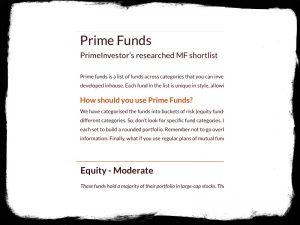Beyond what the numbers say, we look for:
- Clarity in fund strategy
- Consistency in performance across cycles
- Variety in the investing styles of funds we pick and avoid duplication
- Risks that go unnoticed at first glance
- Market scenario and whether the strategy is suitable for the current scenario

There’s a lot more to choosing funds than just ratings. A lot goes into selecting a fund. Fund strategy, ability of the fund to sustain the strategy and generate consistent performance, whether the return generated comes from the same level of risk the fund started out with are just some of the factors beyond the return record. All this in comparison to what peers are doing to deliver. And this is no one-time exercise. Tracking all of these regularly is necessary to stay with the most consistent and the best.
At PrimeInvestor, we do this research and much more into understanding funds and their behaviour, the industry, and the markets. We distilled this into Prime Funds – a list of equity, hybrid, and debt funds that you can invest in. Prime Funds covers different categories and combines different fund styles, which allows you to effortlessly build your own portfolio.
How we choose funds, beyond ratings
Prime Ratings, our exhaustive in-house fund rating system, serves as a strong base. On top of it, we look at a host of other metrics to further shortlist the better funds among the outperformers or to make a choice between quality funds.
Next, we don’t take just the 5-star funds in each category to decide the Prime Funds list. Why? One, it may not necessarily help you build a portfolio that combines different investment styles or market segments. Two, it does not really tell you the risk level of the fund as categories mask actual risk involved. Three, it may leave out up-and-coming funds or those turning around that could give higher returns.
So while quantitative metrics show how a fund has performed, adding qualitative factors helps pick the best among these. That includes looking at fund strategies, portfolios, fund manager changes, overlaps with index and with other funds, market conditions, potential, and so on. Blending quantitative and qualitative metrics, thus, gets us to a list of funds that have been good performers and can continue to be so.
Here’s how we build Prime Funds
Clarity
Where do returns come from? Clarity in fund strategy is essential to understand whether the fund can continue to sustain its returns. Good performance doesn’t necessarily mean a clear strategy – in equity funds, for example, buying a few bank or consumer stocks would have served well in the past few years. A dynamic bond fund may have got this rating cycle right, but may have miss-stepped the earlier one. When a fund’s strategy is understandable and clear, it provides comfort that it will continue to deliver across market cycles. An above-average performance with a steady strategy is preferable to a chart-topper with a muddled/high-churn portfolio. Defined strategies also reduce the impact of fund manager changes. In Prime Funds, we look for strategies that are clear, sustainable, and have the potential to deliver.
Consistency
Variety
Risk
Potential
There are funds that have been turning around – they could be recovering from a slump, they could have seen a fund manager change, they could be following a contrarian strategy. There are funds that could be new. These may not hold up on past performance but could well be great future performers. So while the quants wouldn’t say yes, our assessment of the fund’s potential very well could.
Markets
Bucketing funds usefully
SEBI categories in both equity and debt often have overlaps in terms of fund profile. A low duration debt fund can serve the exact same purpose an ultra-short duration fund can serve. Similarly, an equity multi-cap fund may have a value strategy, while there is also a separate value category. So, there’s little reason to have funds for every labelled category. Also, not all categories are worth investing in or may just not have good funds.
So, each Prime Funds set combines funds from different categories that still serve the same purpose.
We make it easy for you to choose funds by bucketing them into segments you can relate to easily.
For equity funds, Prime Funds sets are classified based on risk level involved and investment style. The two main sets are Moderate Equity Funds, which typically have 70-75% and higher exposure to large-cap stocks and Aggressive Equity Funds, which have significant exposure to mid-cap and small-cap stocks. Apart from this, there are Index Funds, where we see them being good alternatives to active funds and Tax-saving Funds for our Section 80C needs.
For hybrid funds, Prime Funds sets are classified based on risk level. The funds include only equity-oriented funds. We’ve avoided conservative hybrid funds (debt-oriented hybrids) as performances of funds were not up to the mark, or involved credit risk, or returns were easily met by lower-risk equity hybrids or simply debt funds. The hybrid funds in our list are of two kinds: Moderate Risk funds that are plain-vanilla hybrid funds blending equity and debt, and Low Risk funds that are either equity savings or arbitrage funds, which use derivatives in addition to equity and debt to hedge risk.
For debt funds, our classification is based on the timeframe you have when you invest. So, progressively, we move from 3 months-1.5 years, to 1.5 years-3 years, to 3 years-5 years, to above 5 years. We have done this for two reasons: one, it helps you choose funds directly and easily based on the time frame of your goals. Two, and more importantly, the SEBI classification currently does either a credit-risk based segmentation, or a time frame based one.
For example, a short-term debt fund can still have higher credit risk. This is not ideal if you need a fund for the short term. Similarly, you do not know whether you are taking on lower or higher risks with a medium duration fund. Your risk-taking ability is ignored if you go by the regulatory classification. Our classification ensures that you get the right fund with the right risk level for that timeframe. We also have liquid fund recommendations. While we’ve defined the minimum timeframe, you can hold the funds for longer periods if you wish. This is also the reason you may find the same fund appearing in multiple sets.
You can use Prime Funds to build your own portfolio. Each Prime Funds set contains a range of funds with different risk levels and strategy to suit any investor. Remember to build an asset-allocated and category-allocated portfolio based on your risk and timeframe.
We’ll review and update Prime Funds on a quarterly basis. The review will let you know the changes you may need to make, so you can be assured of staying with the funds most suitable for you at all times.
In short, our research uses a unique blend of taking cognisance of past performance without losing sight of what the future holds

